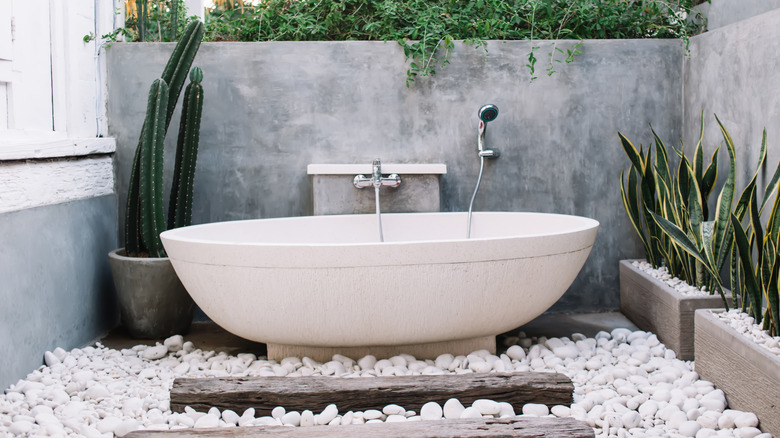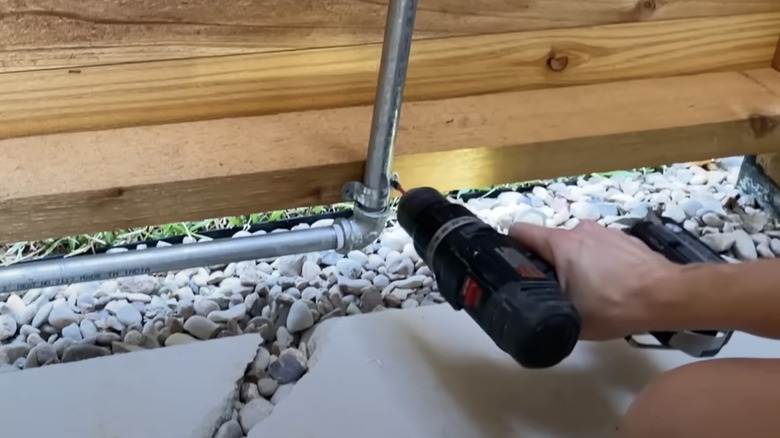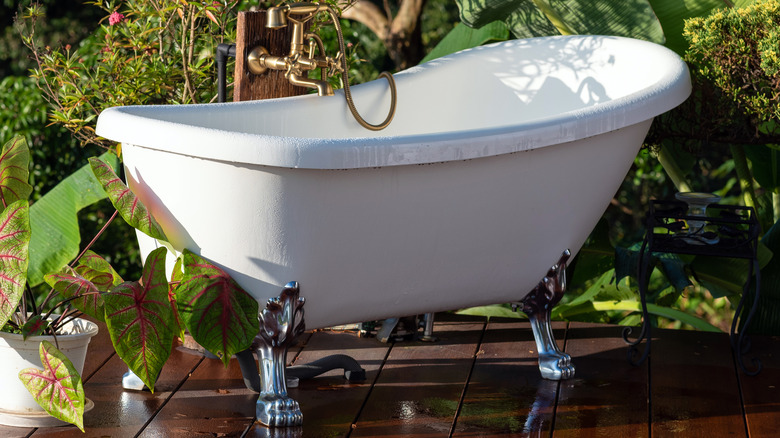How To DIY A Gorgeous Outdoor Soaking Tub For Your Garden (And Whether It's Worth It)
Who says a bathtub can only be indoors? A soaking tub with an included shower can really take your garden to a whole new level. And the best part is that DIYing one is easier than you might think. First things first, you'll need to buy an outdoor soaking tub. You can typically find one at a good price on online marketplaces — or even antique shops if you're going for a more vintage vibe. You could even upcycle a bathtub. Other materials that you'll need include a shower head, a 90-degree FIP, a 90-degree MIP, pipe straps, a water valve, copper or PEX pipes, PEX cutting tools or soldering equipment, and plumber's tape, along with anything you need to build the wooden base and connect the plumbing. One note about copper pipes: if you're not comfortable with soldering, you can leave this part to a plumber.
You'll want to start by prepping the area, which should be near existing plumbing for easy water access. Clear out the spot where you're adding the tub. Bonus points if it's underneath a DIY pergola with some climbing plants. This way, you'll have some privacy and a convenient place to install the pipes and the showerhead. Some string lights along the pergola ceiling will provide some much-needed illumination in the evenings. Alternatively, you can install a 10-foot tall 4-by-4 post for a freestanding shower above the tub or simply use a wall for the fixtures. Remember to wear safety goggles and gloves when you're cutting wood. You may also need a permit if you're changing your home's plumbing.
DIYing an outdoor tub and shower combination
Start by installing the pipes on the structure behind the tub — be it a wall, a 4-by-4 post, or pergola side panels. Using pipe straps, mount a 90-degree FIP at the top and a 90-degree MIP at the bottom. Run pipes from the FIP to the MIP with a water valve in the middle, wrapping the connections with plumber's tape to avoid leaks. For access to hot and cold water, connect the fixture to your interior plumbing. This involves drilling through your exterior wall to reveal the water line and installing a plumbing tee and isolation valve. A plumber can help with this step, or a tankless water heater could be used instead. When the plumbing is ready, mount the shower head above. If you're using a 4-by-4 post for the shower, treat the wood with timber oil for basic waterproofing.
Next up is the base. Note that a bathtub full of water can weigh more than 1,400 pounds, so you'll need a base that can hold the tub's weight and yours. Build the frame using 2-by-6 boards. Place concrete blocks as corner footings and rest the frame on top. Wooden skirting around the base can conceal the blocks. Fill the frame with boards to form the base, drilling them down, and use timber oil to treat the whole thing. In the meantime, resurface and paint your tub if necessary, then position it on top of the base. For drainage, connect a hose/pipe at the bottom of the tub that leads to a French drain or a garden (as long as the water is free from chemicals).
The pros and cons of an outdoor bath-shower
You can take your patio up a notch by adding a garden soaking tub and shower combination. This kind of project may be worth the time and effort if you have room to spare in your garden and enjoy spending time there. It can elevate your outdoor living space, and it's compact enough to fit in smaller backyards. You can even add visual interest by placing some plants around the tub for a spa-like atmosphere. Chances are, you'll also want a bit of privacy for your outdoor tub, and bamboo screens do the job perfectly. They don't cost much and are easy to set up. Plus, an outdoor tub is a cheaper alternative to a swimming pool — and basically a weekend retreat right in your backyard.
Now, there are some factors you should account for when planning to DIY an outdoor tub and shower. To begin with, you'll need to perform regular maintenance. You'll want to keep your tub in tip-top shape, and it being exposed to the elements won't make that easy. Dust and debris can build up around the tub and on the shower head. And let's not forget the water bill. The extra water you use for your outdoor bathing area — on top of the water you use indoors — can break the bank. When temperatures drop too low, you may not want to soak outside. As mentioned, you may need a permit to do the plumbing work. But if none of these cons are an issue for you, then an outdoor soaking tub can definitely be worth the effort.


